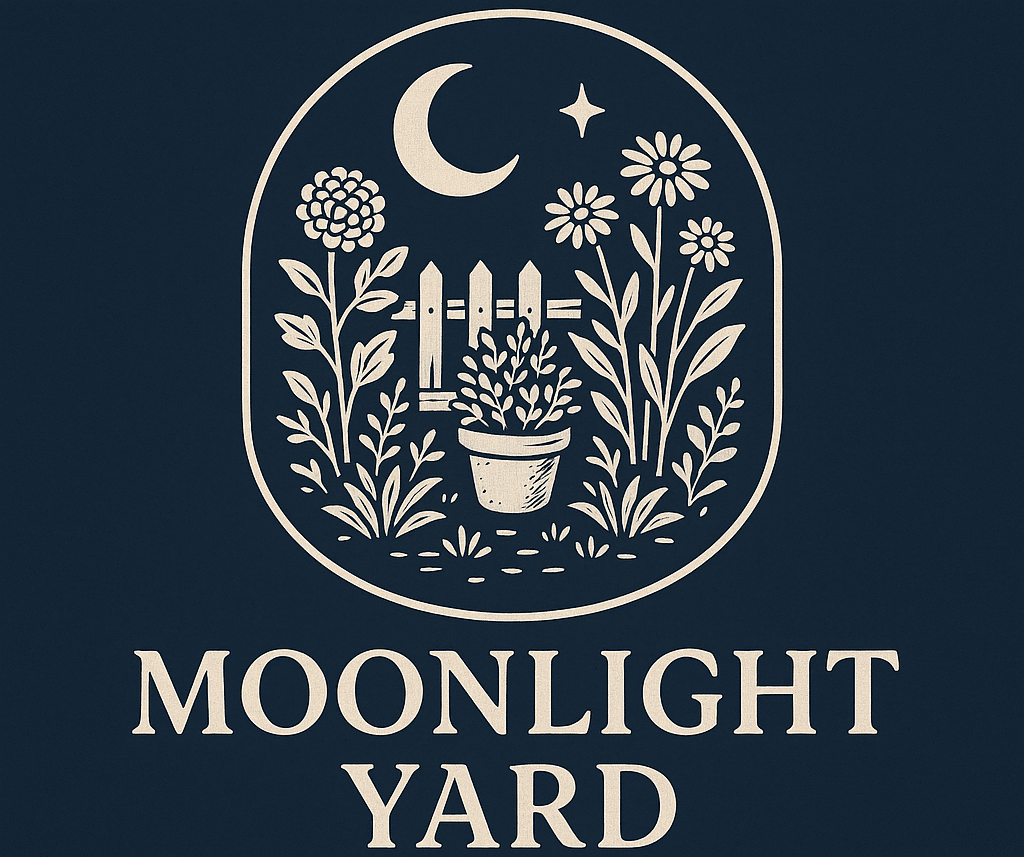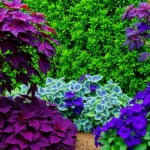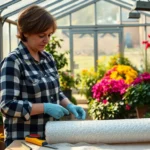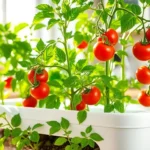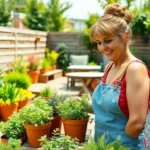We’ve all dreamed of transforming that empty corner of our yard into a thriving garden nursery that produces beautiful plants year after year. Whether you’re looking to grow vegetables for your family’s table or cultivate stunning flowers to brighten your industry, creating the perfect nursery space doesn’t have to expensive or require advanced horticultural skills.
The key to a successful garden nursery lies in smart planning and creative answers that maximize your growing potential. From repurposing everyday items into plant containers to designing efficient watering systems, we’ll explore innovative approaches that turn any space into a productive growing haven.
Ready to discover how simple changes can transform your gardening game? We’re about to share practical nursery ideas that’ll help you grow healthier plants while saving time and money in the process.
Start With Small-Scale Container Gardens
Container gardening offers the perfect entry point for aspiring nursery owners who want to test their skills before expanding. We’ll walk you through building a foundation that grows with your confidence and experience.
Choose the Right Container Sizes
Small containers (6-8 inches) work best for herbs like basil, oregano, and thyme that don’t need extensive root systems. These compact options let us experiment with different plant varieties without overwhelming our space or budget.
Medium containers (10-12 inches) accommodate vegetables such as lettuce, spinach, and cherry tomatoes that require moderate growing room. We recommend starting with these sizes since they balance plant health with manageable maintenance requirements.
Large containers (14+ inches) support substantial plants including peppers, eggplants, and small fruit trees that develop extensive root networks. These investments pay off when we’re ready to scale up our nursery operations.
Drainage considerations matter more than container material, so we always drill holes in the bottom of repurposed items like old buckets or storage bins. Proper water flow prevents root rot and keeps our starter plants healthy throughout their development.
Select Easy-to-Grow Starter Plants
Leafy greens like lettuce, kale, and Swiss chard germinate quickly and tolerate beginner mistakes better than sensitive varieties. We suggest starting with these reliable options since they provide fast results and boost our gardening confidence.
Herbs including parsley, cilantro, and chives grow consistently in containers and offer immediate practical benefits for our kitchens. These plants also command higher prices at farmers markets, making them profitable choices for future nursery sales.
Marigolds and zinnias represent foolproof flower options that bloom continuously with minimal care requirements. Annual flowers like these teach us essential nursery skills while adding visual appeal to our growing operation.
Tomato seedlings from determinate varieties stay compact and produce reliable harvests in container environments. We choose cherry tomato types since they mature faster and give us quicker feedback on our growing techniques.
Plan Your Layout for Maximum Efficiency
Vertical arrangements using plant stands or hanging baskets multiply our growing space without expanding our footprint. We stack containers at different heights to ensure each plant receives adequate sunlight exposure.
Grouping by water needs simplifies our maintenance routine and prevents over or under watering sensitive varieties. Plants with similar moisture requirements go together, streamlining our daily care schedule.
Morning sun placement works best for most container plants, so we position our layout to catch early light while avoiding harsh afternoon heat. East facing locations provide ideal growing conditions for the majority of our starter varieties.
Easy access paths between container groups let us reach every plant for daily monitoring and harvesting tasks. We leave at least 18 inches between rows to accommodate watering equipment and allow comfortable movement through our nursery space.
Create Dedicated Propagation Areas
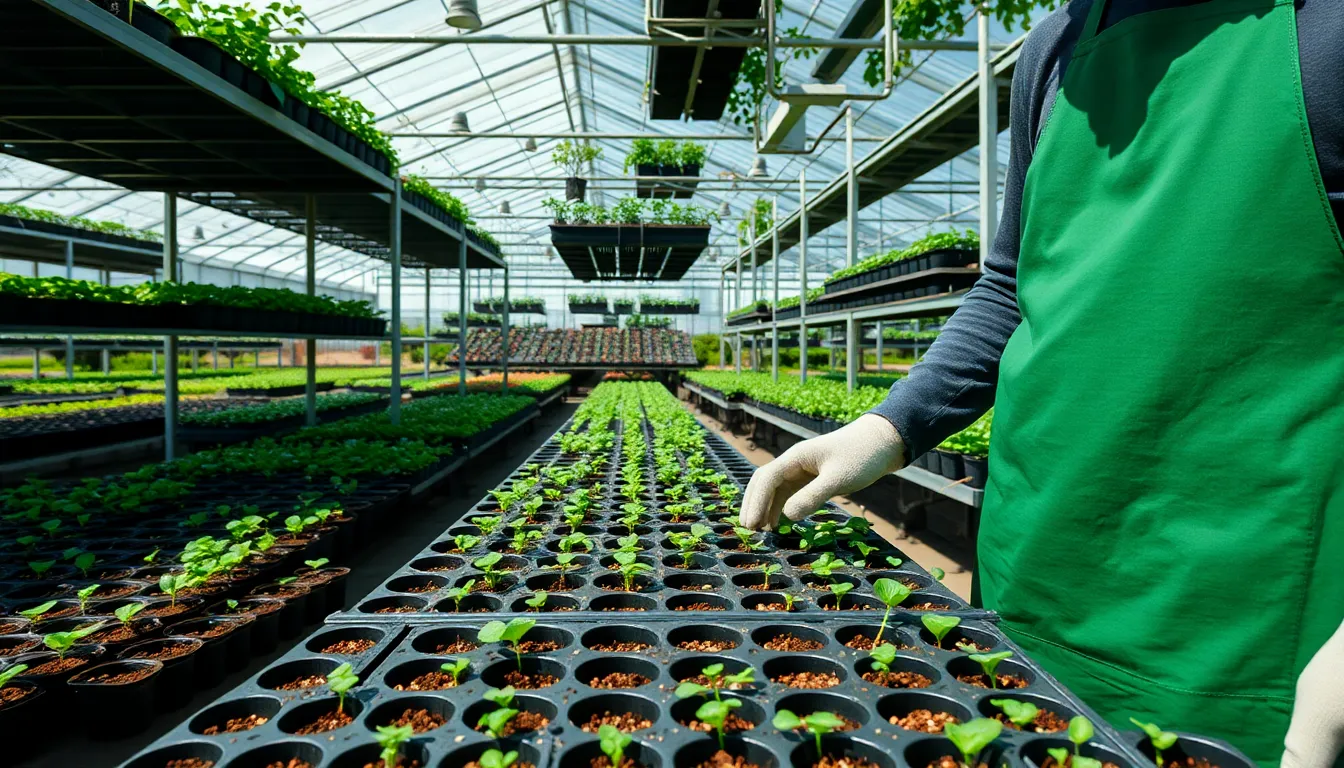
Building on our container garden foundation, we’ll now establish dedicated spaces where new plants begin their journey. These propagation areas serve as the central hub of our nursery operations, requiring strategic positioning that’s both accessible to our production zones and equipped with proper infrastructure to support plant multiplication.
Set Up Seed Starting Stations
Controlled environments become essential when we’re establishing our seed starting operations. We need to maintain precise temperature ranges between 65-75°F and humidity levels around 70-80% for optimal germination rates. Greenhouse structures or indoor setups with environmental controls ensure consistent conditions regardless of outdoor weather fluctuations.
Soil preparation directly impacts our germination success rates. We should use well-drained, aerated growing mediums that allow proper moisture retention without becoming waterlogged. Quality seed starting mixes contain vermiculite, peat moss, and perlite combinations that provide the ideal texture for emerging seedlings.
Workspace organization streamlines our daily seed starting routines. We can install tiered shelving systems that maximize vertical space while keeping seed trays at comfortable working heights. Label stations and storage areas for seeds, tools, and supplies should be within arm’s reach of our main work surface.
Design Cutting Propagation Zones
Strategic placement of our cutting preparation areas should connect directly to our main propagation space while staying close to stock plants. We recommend allocating 20% to 25% of our container production area size specifically for stock block maintenance, ensuring fresh cutting material stays readily available.
Protective structures allow us to continue cutting preparation during challenging weather conditions. Simple hoop houses or covered work areas keep our propagation schedule consistent while protecting both workers and plant materials from rain, wind, or excessive sun exposure.
Rooting medium selection determines cutting success rates across different plant species. We should prepare various rooting substrates including perlite-based mixes for softwood cuttings, sand-peat combinations for hardwood specimens, and specialized hormone treatments that accelerate root development.
Install Proper Lighting Systems
Spectrum requirements vary significantly between seedlings and mature cuttings in our propagation areas. We need full-spectrum LED systems that provide 6000K to 6500K color temperatures for vegetative growth, delivering 20-40 watts per square foot of growing space.
Energy efficiency considerations help us maintain profitable operations while supporting healthy plant development. Modern LED fixtures consume 50-80% less electricity than traditional fluorescent systems while producing less heat, reducing our cooling costs and preventing seedling stress from excessive temperatures.
Timing controls automate our lighting schedules to match natural photoperiods or extend growing seasons. We can program 14-16 hour light cycles for rapid seedling development or adjust timing based on exact crop requirements, ensuring consistent growth patterns throughout our propagation areas.
Establish Customer-Friendly Display Zones
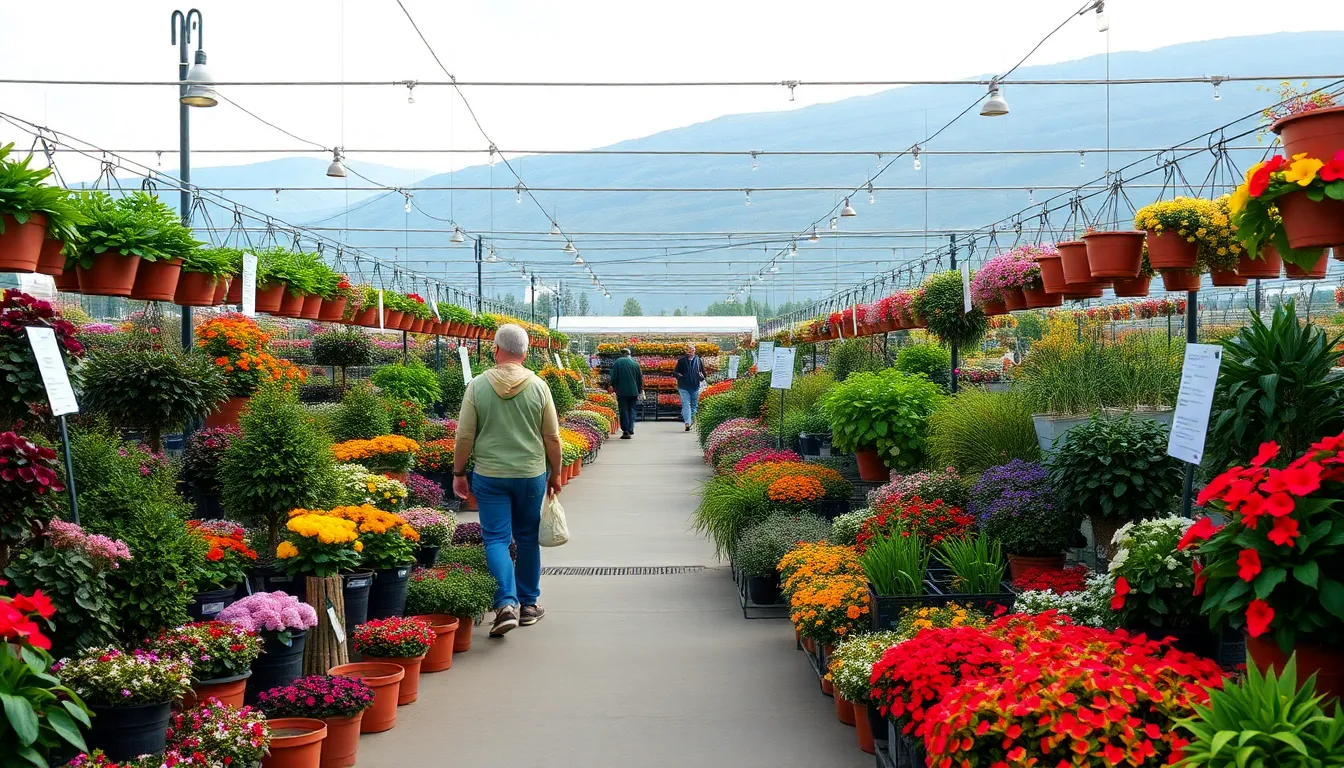
Once we’ve mastered propagation techniques, we need to focus on creating an organized retail space that helps customers navigate our nursery effortlessly. Strategic display zones transform a simple plant collection into an captivating shopping experience.
Organize Plants by Category and Season
Group plants into distinct themed sections to simplify customer browsing and boost sales efficiency. Fruit plants deserve their own dedicated area where customers can compare varieties and learn about harvest seasons. Vegetable seedlings work best when organized by planting schedules, with cool-season crops like lettuce separated from warm-season tomatoes. Ornamental plants should occupy prime real estate near the entrance where their visual appeal draws customers deeper into our nursery. Medicinal and aromatic herbs create natural clusters that allow customers to smell and experience these specialty plants.
Seasonal displays capture customer attention by highlighting plants ready for immediate planting. Spring sections showcase cool-weather vegetables and early blooming perennials during March and April. Summer zones feature heat-loving annuals and warm-season vegetables when temperatures rise above 70°F consistently. Fall displays emphasize autumn planting opportunities with trees, shrubs, and cool-season crops for winter harvests.
Growth habit categorization helps customers visualize mature plant sizes in their gardens. Trees require spacious displays that demonstrate their eventual canopy spread and mature height potential. Shrubs benefit from groupings that show various sizes from compact dwarf varieties to larger screening plants. Vines need vertical display structures that demonstrate their climbing potential and support requirements.
Create Inspiring Garden Vignettes
Design themed garden displays that showcase plant combinations and inspire customer purchases. Container gardens demonstrate how customers can create beautiful arrangements using plants from different nursery sections. Pollinator gardens combine flowering plants that attract bees and butterflies while showing natural network relationships. Edible landscapes blend vegetables with ornamental plants to prove that productive gardens can be visually stunning.
Small demonstration gardens provide real-industry examples of successful plant partnerships. Shade gardens feature hostas, ferns, and understory plants arranged to show layered planting techniques. Rock gardens combine drought-tolerant plants with decorative stones to demonstrate low-maintenance landscaping options. Herb spirals showcase vertical growing techniques while organizing culinary herbs by water and sunlight needs.
Seasonal vignettes rotate throughout the year to maintain fresh visual interest and promote timely plant sales. Spring combinations highlight early blooming bulbs paired with emerging perennials and fresh annual color. Summer displays feature heat-tolerant plants that thrive during peak growing season. Fall arrangements emphasize plants with autumn interest like colorful foliage and ornamental grasses.
Add Clear Labeling and Care Instructions
Install comprehensive plant labels that provide essential growing information at point of sale. Plant names should include both common and scientific names to help customers communicate with other gardeners and research additional information. Basic care requirements need to specify sunlight needs, water frequency, and mature size expectations. Hardiness zones help customers determine if plants will survive their local climate conditions.
Information boards positioned near each plant category educate customers about proper planting and maintenance techniques. Watering guides explain frequency recommendations and signs of overwatering or drought stress. Fertilizing schedules outline seasonal feeding requirements and appropriate fertilizer types for different plant categories. Pruning instructions provide timing guidance and basic techniques for maintaining plant health and shape.
Digital QR codes on plant tags connect customers to detailed care videos and troubleshooting resources. Growing tips accessible through smartphone scans provide expanded information beyond what fits on physical labels. Problem solving guides help customers identify and address common pest and disease issues. Companion planting suggestions recommend beneficial plant combinations that improve garden success rates.
Build Functional Growing Infrastructure
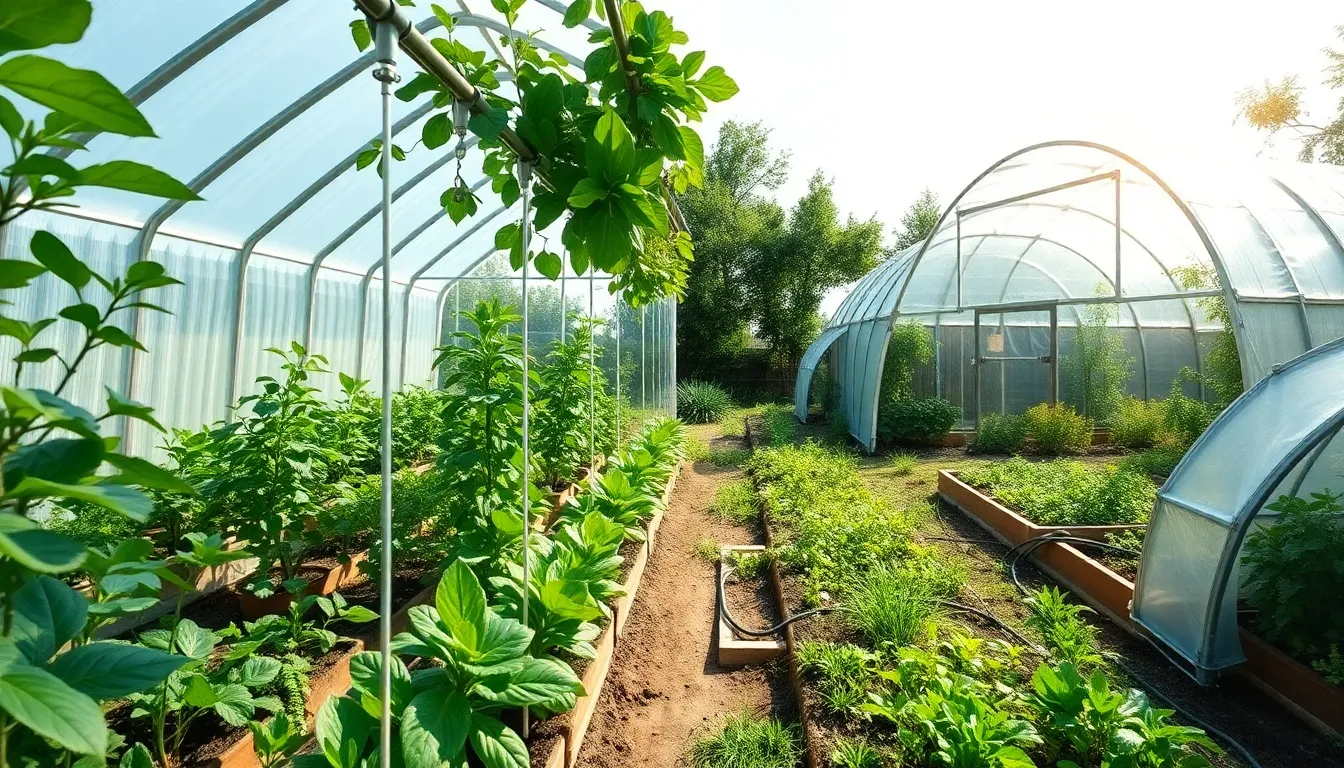
Now that we’ve established our display zones and propagation areas, it’s time to focus on the backbone of any successful garden nursery: robust growing infrastructure that supports healthy plant development year round.
Install Greenhouse or Hoop House Structures
Greenhouses offer the ultimate controlled environment for our nursery operations, providing complete protection from weather conditions and pests while allowing us to regulate temperature and humidity precisely. We can grow sensitive plants throughout the year and extend our growing seasons significantly with these permanent structures. Modern greenhouse materials like polycarbonate panels provide excellent insulation while maintaining optimal light transmission for plant growth.
Hoop houses present a more budget friendly alternative that still delivers impressive results for season extension and protecting hardy plants. We can construct these versatile structures using PVC or galvanized steel hoops covered with greenhouse plastic, creating microclimates that protect plants from frost and wind. These portable structures work exceptionally well for starting seedlings in early spring or extending harvests into late fall.
Both options allow us to control growing conditions more effectively than outdoor cultivation alone. We should consider our climate, budget, and long term nursery goals when choosing between permanent greenhouse structures or flexible hoop house systems.
Set Up Efficient Irrigation Systems
Drip irrigation systems deliver water directly to plant roots, reducing runoff and evaporation while ensuring consistent moisture levels throughout our nursery. We can install emitter lines that provide precise water delivery to each plant, minimizing waste and preventing overwatering issues that commonly plague traditional sprinkler systems. These systems work particularly well in greenhouse environments where we need exact moisture control.
Soaker hoses provide another excellent option for gentle, consistent watering that penetrates soil gradually without creating surface runoff. We can lay these porous hoses throughout our growing beds, connecting them to timers for automated watering schedules that maintain optimal soil moisture. This method works especially well for raised beds and container growing areas.
Water efficient irrigation becomes crucial for maintaining healthy plants while reducing operational costs. We should install systems that allow zone exact watering, enabling us to provide different moisture levels for various plant types and growing stages.
Design Proper Drainage Answers
Slope and grading form the foundation of effective drainage in our nursery space, ensuring water flows away from buildings and prevents accumulation around plant roots. We need to establish gentle slopes that direct excess water toward designated drainage areas without creating erosion problems. Proper grading prevents waterlogged soil conditions that lead to root rot and other moisture related plant diseases.
Drainage channels provide essential pathways for excess water removal, especially during heavy rainfall or irrigation cycles. We can install French drains, surface channels, or underground drainage pipes to manage water flow effectively. These systems become particularly important in areas with clay soil or naturally poor drainage conditions.
Strategic placement of drainage infrastructure protects our investment in plants and growing structures. We should position drainage outlets away from our main growing areas while ensuring they don’t create flooding issues for neighboring properties or natural areas.
Develop Specialized Plant Collections

Creating specialized plant collections sets our nursery apart from generic garden centers and attracts dedicated plant enthusiasts willing to pay premium prices for unique specimens.
Focus on Native Plant Varieties
Native wildflowers offer exceptional value for customers seeking low maintenance plants that naturally attract local pollinators. We can stock varieties like black-eyed Susan, purple coneflower, and bee balm that thrive without intensive care routines.
Oak trees represent an excellent native species investment since they provide wildlife habitats and long-term value for customers planning established landscapes. These trees require minimal intervention once established and appeal to environmentally conscious gardeners.
Regional native grasses create another profitable niche, especially warm-season varieties that withstand drought conditions better than traditional lawn alternatives. Buffalo grass and blue grama work well in western regions, while customers in humid climates prefer native sedges and rushes.
Cultivate Rare and Unique Species
Catnip (Nepeta cataria) presents a surprisingly profitable specialty crop since it’s easy to grow and appeals to cat owners seeking natural pet entertainment. This hardy perennial requires minimal care and produces multiple harvests throughout the growing season.
Hazel trees (Corylus avellana) offer dual benefits for customers interested in edible landscaping and sustainable materials. These trees produce nuts for consumption while providing branches suitable for coppicing and fence construction projects.
Unusual succulents like lithops and haworthia varieties attract collectors willing to pay premium prices for rare specimens. We can propagate these slowly but charge significantly higher margins than common houseplants.
Offer Seasonal and Holiday Plants
Spring container gardens featuring tulips, ferns, and pansies capture customers eager to refresh their outdoor spaces after winter dormancy. These ready-made combinations save customers time while generating higher profits than individual plant sales.
Fall containers using snapdragons and sedum varieties extend our selling season into autumn months when many nurseries see declining sales. These combinations showcase plants that actually prefer cooler temperatures and look their best during fall displays.
Holiday plants like poinsettias for Christmas and cyclamens for fall celebrations create predictable revenue streams during exact seasons. We can pre-order these specialty crops and market them heavily during their peak demand periods to maximize profits.
Incorporate Educational and Workshop Spaces

Transforming your nursery into an educational hub opens up new revenue streams while building stronger community connections. Workshop spaces attract families, schools, and gardening enthusiasts who value hands-on learning experiences.
Create Demonstration Garden Areas
Sensory gardens provide diverse learning experiences that engage visitors through touch, smell, and sight. We recommend incorporating textured plants like lamb’s ear, aromatic herbs such as lavender and rosemary, and visually striking flowers to accommodate different learning styles.
Pollinator gardens showcase native plants that attract bees, butterflies, and hummingbirds while teaching network balance. Plant native wildflowers like black-eyed Susan, bee balm, and purple coneflower to demonstrate biodiversity principles and support local wildlife populations.
Fruit and vegetable demonstration plots connect visitors to food production and nutrition education. Establish raised beds featuring seasonal vegetables, berry bushes, and dwarf fruit trees to show customers successful growing techniques while inspiring their own edible garden projects.
Themed garden vignettes demonstrate exact plant combinations and growing methods. Create container gardens showcasing companion planting, vertical growing systems, and seasonal arrangements that customers can replicate at home.
Set Up Potting and Activity Stations
Potting stations equipped with accessible work surfaces encourage hands-on learning for all ages. Install adjustable height tables, provide child-sized tools, and stock various pot sizes to accommodate different skill levels and physical abilities.
Activity zones support multiple workshop formats throughout the growing season. Designate areas for seed starting workshops, plant propagation classes, and seasonal create activities like wreath making or terrarium building.
Tool storage keeps workshop materials organized and accessible during educational sessions. Install weatherproof cabinets near activity stations to house soil amendments, hand tools, watering equipment, and safety supplies needed for various workshops.
Water access points streamline cleanup and plant care during workshop activities. Position water spigots within 25 feet of all activity stations to support efficient watering demonstrations and easy cleanup after messy potting sessions.
Design Comfortable Seating Areas
Shaded seating under trees or pergolas provides comfortable outdoor classroom spaces year-round. Install benches or moveable chairs that accommodate 15-20 participants for larger workshop groups while maintaining clear sightlines to demonstration areas.
Reading nooks offer quiet spaces for plant research and garden planning between workshop sessions. Create intimate seating areas with weather-resistant cushions where visitors can browse gardening books, catalogs, and plant reference materials.
Group gathering spaces support storytelling sessions and group discussions about gardening experiences. Arrange seating in circular or semicircular patterns that promote interaction while keeping the instructor visible to all participants.
Weather protection ensures year-round workshop capabilities regardless of seasonal conditions. Install retractable awnings or permanent gazebos over key seating areas to provide shelter during unexpected rain or intense summer heat.
Add Value-Added Services and Products

Beyond growing plants, we can transform our nursery into a comprehensive gardening destination by expanding our offerings to meet diverse customer needs.
Stock Garden Tools and Supplies
Essential tools form the backbone of every successful garden nursery. We should stock a variety of hand tools including trowels, pruners, and cultivators that appeal to both novice and experienced gardeners. Quality soil amendments and seed starters deserve prominent placement since customers often purchase these items alongside plants.
Fertilizers and pesticides represent high-margin products that complement plant sales. We can offer organic options, synthetic fertilizers, and targeted pest control answers to address exact gardening challenges. Watering supplies like hoses, sprinklers, and drip irrigation components help customers maintain their purchases successfully.
Seasonal supplies keep customers returning throughout the year. We should rotate inventory to include spring planting supplies, summer maintenance tools, fall cleanup equipment, and winter protection materials.
Offer Custom Potting Services
Personalized planters create memorable experiences that justify premium pricing. We can set up potting stations where customers choose their favorite containers, plants, and soil combinations to create unique arrangements. This hands-on service appeals to gift buyers and customers seeking instant gratification.
Succulent and herb planters tap into current gardening trends. We should focus on these popular categories since they require minimal maintenance and appeal to urban gardeners with limited space. Pre-made arrangements can serve as inspiration while custom services allow for personalization.
Seasonal container gardens extend our service offerings year-round. We can create holiday-themed planters, seasonal color combinations, and weather-appropriate arrangements that reflect current gardening seasons.
Create Gift and Decoration Sections
Garden decorations expand our customer base beyond traditional plant buyers. We should stock items like garden statues, fountains, wind chimes, and decorative planters that enhance outdoor spaces. These products appeal to customers focused on aesthetics rather than growing.
Gardening-themed gifts attract non-gardening customers looking for presents. We can offer items such as gardening books, themed accessories, decorative gloves, and plant-related home decor. These products work well for holidays, birthdays, and housewarming gifts.
Seasonal decorations create urgency and repeat visits. We should rotate displays to feature spring garden flags, summer outdoor lighting, fall harvest decorations, and winter garden protection items that encourage multiple visits throughout the year.
Plan for Seasonal Operations

We must strategically plan our nursery operations around seasonal demand cycles to maximize profitability. Planning orders 6 months in advance ensures we’re ready for peak seasons and customer needs.
Design Winter Protection Systems
Insulation materials become our primary defense against freezing temperatures during winter months. Straw and foam materials protect plant roots from harsh winter conditions that could damage or kill valuable inventory.
Shelter construction protects our plants from destructive wind and frost damage. Greenhouses and cold frames create controlled environments that maintain consistent temperatures and humidity levels throughout winter.
Irrigation management requires careful adjustment during colder months to prevent overwatering. Reduced watering schedules prevent root rot while ensuring plants receive adequate moisture for survival.
Prepare Spring Rush Infrastructure
Advanced ordering requires placing spring plant and material orders well ahead of peak season demand. Historical sales data from previous spring seasons guides our ordering quantities and timing decisions.
Seasonal staffing preparation involves hiring temporary employees based on projected sales volumes. Peak spring periods demand additional workforce to handle increased customer traffic and plant care requirements.
Inventory positioning ensures high demand items like seeds, bulbs, and soil amendments are readily accessible. Strategic placement of spring favorites reduces customer wait times and improves overall shopping experience.
Create Fall and Holiday Displays
Themed display areas showcase seasonal plants and holiday decorations that capture customer attention. Fall foliage arrangements and holiday themed sections create visual appeal and encourage impulse purchases.
Promotional workshops attract customers during traditionally slower fall periods through educational events. Seasonal planting demonstrations and holiday decoration classes generate additional revenue streams beyond plant sales.
Strategic stock management involves matching inventory levels to seasonal demand patterns. Garden tools and mulches receive prominent positioning during autumn months when customers prepare gardens for winter.
Implement Sustainable Growing Practices

Sustainable practices transform our nursery operations into environmentally responsible businesses that reduce costs while attracting eco-conscious customers. These methods create healthier growing environments and support long-term success.
Set Up Composting Systems
Composting systems turn organic waste into nutrient-rich soil amendments that enhance plant health naturally. We can create designated composting areas using three-bin systems that allow for continuous decomposition cycles throughout the year.
Kitchen scraps like fruit peels and vegetable trimmings provide nitrogen-rich materials for balanced compost piles. Fallen leaves, wood chips, and paper materials add essential carbon components that create proper composting ratios.
Regular turning of compost piles every two weeks speeds decomposition and prevents odor issues in our nursery spaces. Temperature monitoring ensures our compost reaches 140-160°F for effective pathogen elimination and faster breakdown.
Finished compost reduces our fertilizer costs by 30-50% while creating healthier soil ecosystems that support beneficial microorganisms. This approach eliminates waste disposal fees and transforms expenses into valuable growing resources.
Install Rainwater Collection
Rainwater harvesting systems reduce our water costs and provide chemical-free irrigation for sensitive plants and seedlings. We can install collection barrels under downspouts to capture roof runoff during seasonal precipitation events.
Storage capacity calculations based on roof square footage help determine optimal barrel sizes for our exact nursery requirements. A 1,000 square foot roof generates approximately 600 gallons from one inch of rainfall.
Filtration systems remove debris and contaminants before water enters our storage containers or irrigation networks. Simple screen filters and first-flush diverters prevent leaves and pollutants from compromising water quality.
Distribution methods like gravity-fed drip systems deliver collected rainwater directly to plant root zones efficiently. This conserves our harvested water while maintaining consistent soil moisture levels throughout growing seasons.
Use Organic Growing Methods
Organic growing methods eliminate chemical dependencies while creating healthier plants that resist pests and diseases naturally. Beneficial insects like ladybugs and lacewings provide effective pest control without harmful residues or environmental damage.
Natural fertilizers from compost tea and fish emulsion deliver balanced nutrition that promotes strong root development. These organic amendments release nutrients slowly and improve soil structure over extended periods.
Companion planting strategies use marigolds, basil, and other aromatic plants to repel harmful insects naturally. These partnerships reduce pest pressure while maximizing growing space efficiency in our nursery beds.
Soil testing every six months guides our organic amendment applications and ensures optimal pH levels for different plant species. This precision approach prevents nutrient deficiencies and maintains healthy growing conditions year-round.
Market Your Garden Nursery Effectively

We’ve built the perfect growing infrastructure and specialized collections, but now it’s time to attract customers to our garden nursery. Marketing transforms our passion project into a thriving business that serves the gardening community.
Develop Online Presence and Social Media
Facebook, Instagram, and Pinterest showcase our nursery’s diverse plant offerings while providing valuable gardening tips to potential customers. We’ll use these platforms strategically to build engagement through high-quality photos of our plants, behind-the-scenes nursery operations, and seasonal gardening advice that positions us as local experts.
Search engine optimization ensures our website appears when customers search for “nurseries near me” or exact plant varieties we grow. We should focus on location-based keywords and plant-exact content that matches what gardeners in our area actually search for online.
Educational content through workshops and classes builds our reputation as a trusted gardening resource rather than just another plant seller. Topics like container gardening, succulent arrangements, and seasonal plant care attract customers who value expertise alongside quality plants.
Publishing authority content on our blog or social media establishes credibility within the gardening community and improves our search rankings. We can share propagation techniques, seasonal planting schedules, and troubleshooting guides that demonstrate our knowledge while helping customers succeed.
Create Attractive Signage and Branding
Brand identity starts with highlighting our unique selling points like locally grown plants, pesticide-free growing methods, or rare plant varieties that set us apart from big box stores. Clear messaging about what makes our nursery special should appear consistently across all customer touchpoints.
Nature-inspired color palettes create cohesive branding that feels authentic to our gardening focus while remaining professional and memorable. We’ll choose earth tones, plant greens, or flower-inspired colors that reflect our nursery’s personality and appeal to our target customers.
Professional signage throughout our nursery helps customers navigate easily while reinforcing our brand at every turn. Plant labels, directional signs, and promotional displays should use consistent fonts, colors, and messaging that creates a polished shopping experience.
Clear wayfinding and category signs reduce customer frustration and increase sales by making it easy to find exact plants or gardening supplies. We should organize signage by plant types, seasonal categories, and care requirements to match how customers naturally think about their gardening needs.
Build Customer Loyalty Programs
Loyalty programs reward repeat customers with discounts, exclusive plant previews, or special member pricing that encourages continued business throughout the growing season. We can offer punch cards for frequent purchases, seasonal membership programs, or tiered rewards based on annual spending levels.
Exclusive offers for loyalty members create urgency and value that keeps customers coming back to our nursery instead of shopping elsewhere. Early access to new plant arrivals, members-only workshop discounts, or special seasonal events make customers feel valued and connected to our business.
Influencer collaborations with local gardening enthusiasts, industry designers, or social media personalities enhance our credibility and extend our reach to new customer segments. We should partner with people whose audiences align with our target customers and whose gardening philosophy matches our nursery values.
Email newsletters keep our nursery top-of-mind during slow seasons while providing ongoing value through care tips, seasonal reminders, and exclusive promotions. Regular communication helps maintain relationships between visits and encourages customers to think of us first when gardening needs arise.
Conclusion
Creating a thriving garden nursery is within reach when we combine strategic planning with creative answers. We’ve explored how simple container gardens can evolve into sophisticated growing operations that serve both our gardening dreams and our customers’ needs.
The key lies in building sustainable systems that work year-round while developing the educational and marketing components that set us apart from traditional garden centers. By focusing on specialized collections native plants and unique varieties we create lasting value for our community.
Remember that every successful nursery starts with a single planted seed. Whether we’re transforming a backyard corner or planning a larger operation these ideas provide the foundation for growth that’s both profitable and environmentally responsible.
Frequently Asked Questions
What supplies do I need to start a backyard nursery?
You don’t need expensive equipment to begin. Start with basic containers of varying sizes (small for herbs, medium for vegetables, large for substantial plants), quality potting soil, and simple watering tools. Repurpose everyday items like buckets or wooden crates for planters. Focus on proper drainage by drilling holes in containers to prevent root rot.
Which plants are easiest for beginners to grow in a nursery?
Begin with foolproof varieties like leafy greens (lettuce, spinach), common herbs (basil, mint), hardy flowers (marigolds, zinnias), and compact tomato varieties. These plants are forgiving, grow quickly, and help build confidence. They also have consistent market demand, making them ideal starter crops for new nursery owners.
How should I organize my nursery layout for maximum efficiency?
Plan your space by grouping plants with similar water and light needs together. Use vertical arrangements to maximize space and position frequently accessed plants at eye level. Create clear pathways for easy maintenance and customer browsing. Place your propagation area centrally for efficient workflow between seed starting and plant care.
What’s the best way to create proper drainage in my nursery?
Install a slight slope away from growing areas and add drainage channels to manage excess water. Ensure all containers have adequate drainage holes. Consider raised beds or gravel bases under growing areas. Poor drainage leads to root rot and plant loss, so invest time in proper water management systems.
How can I attract customers to my backyard nursery?
Develop a strong online presence through social media platforms like Instagram and Facebook, showcasing your plants and sharing gardening tips. Create attractive signage, organize plants by categories, and offer clear care instructions with each plant. Consider customer loyalty programs and collaborate with local gardening influencers to expand your reach.
What are the benefits of growing native plants in my nursery?
Native plants require less water, fertilizer, and pest control, reducing maintenance costs. They attract local pollinators and wildlife, appealing to eco-conscious customers. Examples include black-eyed Susan and native oak varieties. Native plants also command good prices due to growing environmental awareness and their proven success in local conditions.
How do I set up an efficient watering system?
Install drip irrigation or soaker hoses for consistent, water-efficient irrigation. Group plants by water requirements to avoid over or under-watering. Consider rainwater collection systems to reduce costs and provide chemical-free water. Automated timers help maintain consistent watering schedules, especially important during busy periods or vacations.
What marketing strategies work best for small nurseries?
Focus on local SEO to appear in “nurseries near me” searches. Use social media to share plant care tips and showcase your inventory. Email newsletters keep customers engaged with seasonal planting advice. Partner with local garden clubs and schools for workshops. Word-of-mouth remains powerful, so prioritize excellent customer service and plant quality.
How can I extend my growing season year-round?
Install greenhouses, hoop houses, or cold frames to protect plants from weather extremes. These structures allow seed starting in late winter and growing tender plants through mild winters. Proper ventilation and temperature control are essential. Season extension increases profitability by expanding your selling season beyond traditional growing months.
What’s the most profitable approach for a small nursery?
Specialize in niche markets like native plants, rare varieties, or seasonal specialties rather than competing with big box stores on common plants. Offer value-added services like custom container gardens or plant care workshops. Focus on quality over quantity, building relationships with customers who appreciate expertise and unique offerings over low prices.
